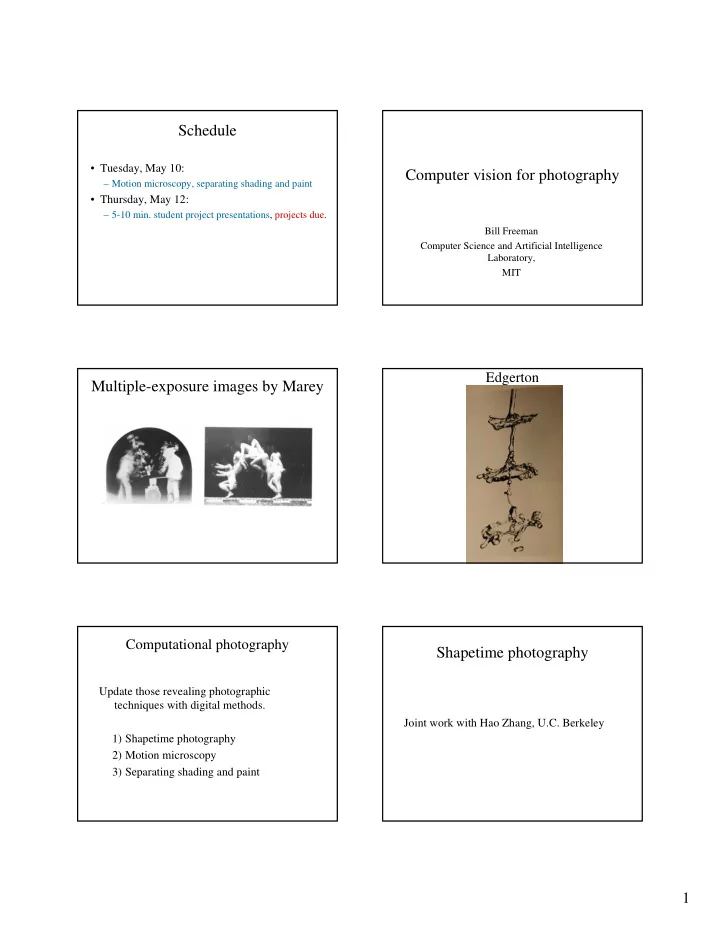

Schedule • Tuesday, May 10: Computer vision for photography – Motion microscopy, separating shading and paint • Thursday, May 12: – 5-10 min. student project presentations, projects due. Bill Freeman Computer Science and Artificial Intelligence Laboratory, MIT Edgerton Multiple-exposure images by Marey Computational photography Shapetime photography Update those revealing photographic techniques with digital methods. Joint work with Hao Zhang, U.C. Berkeley 1) Shapetime photography 2) Motion microscopy 3) Separating shading and paint 1
Video frames Multiple- exposure Layer- Shape- By-Time Time “how to sew” 2
Input sequence Insert pictures describing zcam, and initial results Shape-Time composite “inside-out” Motion Magnification Goal A microscope for motion You focus the microscope by specifying which motions to magnify, and by how Ce Liu Antonio Torralba William T. Freeman much; Fredo Durand Edward H. Adelson the motion microscope then re-renders the input sequence with the desired motions magnified. The naïve solution has artifacts Motion magnification flowchart Original sequence Naïve motion magnification 1 2 3 Input raw video Find feature Cluster Register frames sequence point trajectories trajectories 7 6 5 4 Magnify Render magnified Segment Interpolate dense selected layer, video sequence flow into layers optical flow Fill-in textures Amplified dense Lukas-Kanade optical flow. Layer-based motion analysis Note artifacts at occlusion boundaries. 3
Inliers (red) and outliers (blue) 1 Video Registration • To find a reliable set of feature points that are “still” in the sequence – Detect and track feature points – Estimate the affine motion from the reference frame to each of the rest frames – Select feature points that are inliers through all the frames – Affine warping based on the inliers Registration results 2 Find feature point trajectories • An EM algorithm to find both trajectory and region of support for each feature point – E-step: to use the variance of matching score to compute the weight of the neighboring pixels – M-step: to track feature point based on the region of support • The following feature points are pruned – Occluded (matching error) – Textureless (motion coherence) – Static (zero motion) Learned Robust regions of feature support for point features tracking 4
Use EM to find regions of support and Minimal SSD match to find feature point trajectories prune low-likelihood trajectories 3 Compatibility function used to group 3 Trajectory clustering feature point trajectories We need to cluster trajectories belonging to the same object, despite: ρ n,m : compatibility between the nth and mth point trajectories. Points have different appearances v x (n,k): the displacement, relative to the reference frame, of the nth Undergo very small motions, of varying amplitudes and feature point in the kth frame. directions Vy Vx Vx Vy Using the ρ n,m compatibilities, cluster the point trajectories time using normalized cuts. time Clustering results 4 Dense optical flow field interpolation • For each layer (cluster) a dense optical flow field (per pixel) is interpolated • Use local weighted linear regression to interpolate between feature point trajectories. Dense trajectories interpolated Clustered feature point trajectories for each cluster 5
Motion segmentation results 5 Segment flow into layers Note we have 2 special layers: the background layer (gray), and the outlier layer (black). • Assign each pixel to a motion cluster layer, using four cues: – Motion likelihood – Color likelihood – Spatial connectivity – Temporal coherence • Energy minimization using graph cuts 6, 7 Magnification, texture fill-in and Summary of motion magnification steps rendering • Amplify the motion of the selected layers by warping the reference image pixels accordingly. • Render unselected layers without magnification. • Fill-in holes revealed in background layer using Efros-Leung texture synthesis • Directly pass-through pixel values of the outlier layer. Layered Results representation • Demo 6
Is the signal really in the video? (yes) Original Magnified 25 frames Swingset details 44 frames Bookshelf 480x640 pixels Original Magnified Beam bending Proper handing of occlusions Artifact time time Bookshelf deforms less, further from force Outtakes from imperfect segmentations Original Magnified 44 frames 480x640 pixels time time 7
Breathing Mike Feature points 2 clusters Breathing Mike Original sequence… 4 clusters 8 clusters Standing Mike Breathing Mike Sequence after magnification… Sequence after magnification… Crane Crane 2 clusters Feature points 4 clusters 8 clusters 8
Crane What next • Continue improving the motion segmentation. – Motion magnification is “segmentation artifact amplification”—a good test bed. • Real applications – Videos of inner ear – Connections with mechanical engineering dept. • Generalization: amplifying small differences in motion. – What’s up with Tiger Woods’ golf swing, anyway? Things can go horribly wrong sometimes… 9
Recommend
More recommend